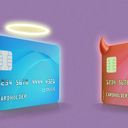How to make credit cards less evil

A new card from the buy now, pay later company Klarna shows that it's possible to build a credit card that isn't designed to trap users in a so-called sweat box.
Why it matters: Only 33% of Americans pay off their credit cards in full every month, per the Philly Fed.
- The rest start paying interest on purchases from Day 1 and often don't stop paying interest — not to mention interest on that interest — for decades.
Roughly half the total amount owed on credit cards is owed by borrowers who have been carrying a balance for at least two years.
- While the average credit card interest rate of 22.6% might be affordable for a short-term loan of a couple of months, it adds up terrifyingly if it's charged month in and month out for years.
By the numbers: Someone who starts with a balance of $10,000 and makes minimum payments on a card with a 24% interest rate would take 25 years to repay the debt — and pay $28,886 in total, per "Delinquent," Elena Botella's account of how credit cards work.
- That's without spending a single extra penny on new purchases.
- Every time you tap your card, you're borrowing money from a bank that would love nothing more than for you to keep that loan on its books for a very long time.
The big picture: A very good payment card for anyone who ever carries a balance on their credit card would:
- Have a complete suite of credit card consumer protections.
- Have no annual fee.
- Allow consumers to wait until after a monthly statement arrives to actually pay for their last month's purchases, and to always be able to do so interest-free.
- Provide simple-interest payment-plan options for anything that can't be paid for in full, where the full purchase ends up being paid off within a few months.
Between the lines: The vast majority of credit cards fail on counts 3 and 4.
- American Express charge cards (green/gold/platinum) provide 1 and 3, and even offer 4, through a little-advertised "plan it" feature, but they fail on 2.
- Customers of Chase and Citi can use the pay over time and flex pay features, respectively, to approximate such a card. But that requires discipline.
Klarna's new card is the first-ever U.S. card to offer all four, the company says.
How it works: With the Klarna card, at the end of every month, every purchase has to be either paid off in full or converted into an installment loan.
- Those loans, which carry an annual interest rate of between 15% and 34%, last between one and six months.
- The installment payments appear on the card statements — but they can't be refinanced. If it's an installment payment then it has to be paid in full.
Follow the money: Klarna claims that only 4% of its BNPL users pay late fees, compared to 23% of credit card users. (Interest on late fees is a particularly insidious part of how credit card companies make money.)
- The Klarna card is less flexible than a traditional credit card, insofar as it doesn't allow you to skate by making tiny minimum payments every month. To put it another way, the Klarna card has much higher minimum payments than almost any credit card.
- The higher minimum payments mean Klarna has to be much more strict about credit limits. The card doesn't allow customers to make new purchases when they are already going to stretch to be able to pay next month's installment loans.
Our thought bubble: That inflexibility is a feature, not a bug, and helps keep the total amount loaned out in check. More cards should work this way.